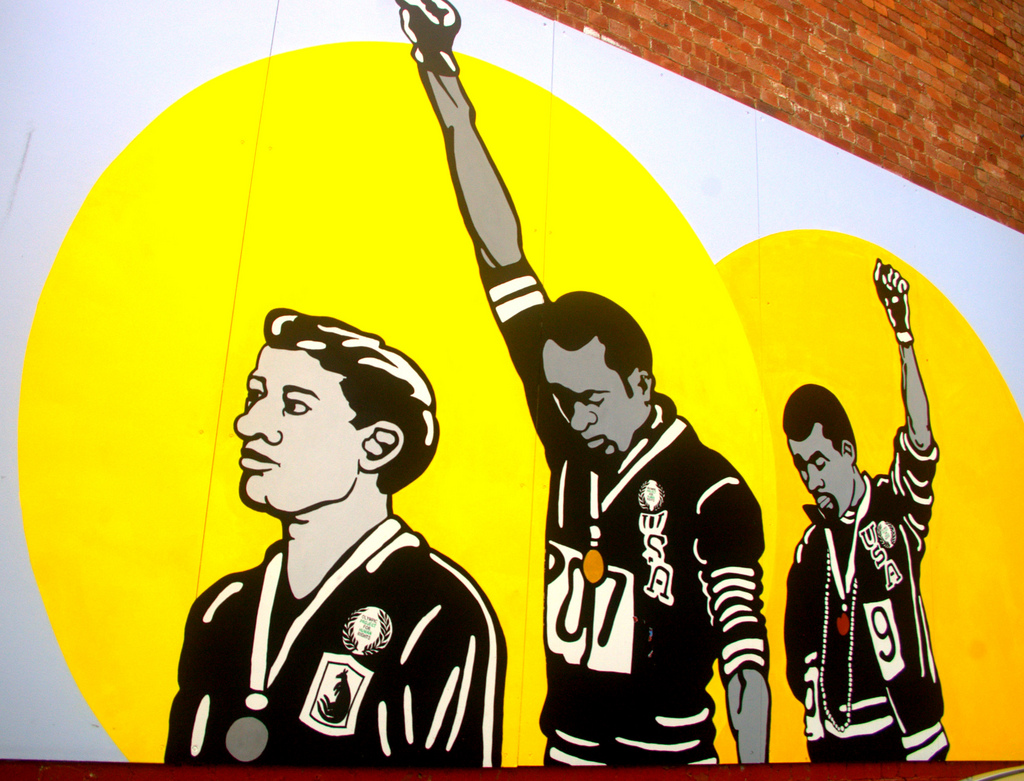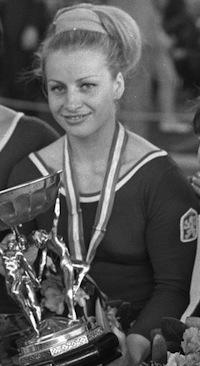
Credit: Rae Allen (Flickr)
Editor’s note: We are re-posting this piece on sport as a stage for protest in light of the debate surrounding the refusals by NFL player Colin Kaepernick and USWNT star Megan Rapinoe to stand during the US National Anthem and in order to acknowledge the life of gymnast Vera Caslavska (who died last week at the age of 74).
We’re nearly a week into the 2014 Olympic Games and no one has had a “John Carlos” moment yet, though many have wondered whether or not the athletes will speak up or act out against Russia’s ruthless and violent repression of their LGBT citizens.
This moment took place in 1968 when Tommie Smith and Carlos, who placed first and third respectively in the men’s 200 meters race, stood on the medal podium in Mexico City shoeless, wearing the badge of the Olympic Project for Human Rights (OPHR), their fists raised in protest as the American national anthem blared in the stadium. Later, the two men explained that they were standing up against racism, African American poverty (hence the shoeless-ness), and in solidarity with workers. For this act of protest, the two were expelled from the Games by International Olympic Committee president Avery Brundage, notorious for his willful blindness toward politics on the Olympic stage.
(Four years later, Brundage would see fit to continue the Games after the massacre of eleven Israeli athletes and coaches in Munich. He also had been the head the American Olympic effort in 1936 and he fought zealously against a boycott of those Olympics despite Hitler’s rise to power and evidence of Jewish persecution and deportations.)
But in 1968, Carlos and Smith were not alone; there was another athlete who protested from the medal stand. Vera Caslavska, twenty-six, was the dominant gymnast of her era. To this day, she is the only female gymnast to have won an Olympic gold medal in every single individual discipline—the all-around, vault, uneven bars, beam, and floor exercise. And she arrived in Mexico City as the heavy favorite to defend her all-around title from 1964, despite the fact that she had been training in the forest—in hiding—after the Soviet tanks rolled through her country to crush the popular “Prague Spring” uprising.
Caslavska, already a famous figure back home before the 1968 Olympics, had signed Ludvik Vaculik’s protest manifesto, “Two Thousand Words.” When the Soviets invade Czechoslovakia in 1968, she had to flee to Sumperk, a mountain town, where she used wooden tree beams in the forest as a balance beam and sacks of flour as weights. It almost sounds like something out of a childhood storybook or a dystopian novel—imagine Snow White practicing beam dismounts under the watchful eyes of the Seven Dwarves or Muhammad Ali being forced underground to box anonymously in Appalachia.

Vera Caslavska (Wikipedia)
Despite her primitive training conditions for the 1968, Caslavska arrived ready in Mexico ready to dominate once again. She defended her all-around title by a hefty margin. She looked primed to win more gold medals in the event finals. She took first on vault and on the uneven bars. And then again on the balance beam until some very iffy judging put Soviet gymnast Natalia Kuchinskaya ahead of Caslavska. The same thing happened on floor exercise, except even more outrageously. Again, Caslavska appeared to have won until the Soviets intervened. In a suspicious move, the judges increased the qualification score of Larisa Petrik, another member of the Soviet team, from several days prior—back in those days, preliminary scores were counted towards the outcome in apparatus finals. This unprecedented move put Petrik into a tie with Caslavska.
Where Carlos and Smith raised fists to affirm black power and human rights, Caslavska turned her head away to resist Communist domination. In both the balance beam and floor exercise medal ceremonies, Caslavska bowed her head down and to the right as the Soviet national anthem played, a symbolic refusal to acknowledge the regime whose repressive tactics had driven her into hiding. Unlike Carlos and Smith, however, she was not expelled from the Games, perhaps because Brundage was fiercely anti-Communist and Caslavska was protesting the Soviet Union, which aligned with his political leanings. Caslavska even got married in Mexico City to fellow countryman and athlete Josef Odložil.
Though she returned to Czechoslovakia as a popular hero, Caslavska was not recognized as such by the government, which was now back under Soviet control. Authorities did not permit her to travel abroad, essentially forcing her into premature competitive retirement. This move also greatly limited her ability to earn money by performing and teaching around the world. It was not until the late 1980s, after pressure from the IOC, that she was permitted to work as a judge and coach in Czechoslovakia.
Four years after Cavlavska’s wins and protests in Mexico City, gymnastics’ first female global superstar debuted on the Olympic stage. Olga Korbut was a seventeen-year-old who performed daring acrobatics on the uneven bars and balance beam. (She was the first to perform a standing back flip on the beam.) But Korbut didn’t just become famous for her athletic feats; rather, she was also famous for her slight stature and charismatic youth. Though a late teen, she worn yarn-tied pigtails that belied her age. She smiled when she hit and cried when she failed. Korbut and her personality showed American audiences that the Soviets weren’t emotionless automatons.
Yet it’s telling that the first female global star in gymnastics was a young girl and not the woman who had quietly protested Soviet aggressions—both while in her home country and on the medal podium. Caslavska, the Olympic champion, won medals while Korbut, the Olympic star, won hearts. Korbut seemed something of a blank slate onto which we could project our fantasies about girlhood and innocence. We lionized the young, charming girl and mostly forgot about the woman who had opinions and expressed them as an activist and as an athlete.
So now the question facing us is, will any athletes have a “Tommie Smith-John Carlos-Vera Caslavska” moment in Sochi? And if so, who will step up? Will it be the LGBT athletes? Or their athlete allies? Or will it be both?
If we use the protests of 1968 as a guide, it’s important to note that Smith, Carlos, and Caslavska were members of and representatives for oppressed groups whose protests they were voicing. Smith and Carlos were protesting the misdeeds of their own governments, not their host country’s government. As African American men, they had been victimized by U.S. racism. Caslavska, too, used the podium as her platform to protest what had happened in her and her fellow citizens back in Prague, which was under Soviet dominion. (In her case, the victimization extended to the Olympics itself, where her results had been manipulated by the Soviets.)
It’s also important to be aware of what it means to be an ally. The actions of Peter Norman, the Australian who stood on the second step of the Olympic podium as Smith and Carlos, offer a good object lesson here. Norman had not at all been surprised by the protest that disrupted what was also his silver medal ceremony for the 200 meters race. He wore the OPHR badge in solidarity (and was personally opposed to his home country’s White Australia Policy). He had even suggested the one-gloved approach when Carlos had realized he had forgotten his pair. Yet on the medal stand, he did not raise his fists and copy the actions of Carlos and Smith. He stood in support but the grievance and the actions were theirs alone. He didn’t try to “co-opt” their protest.
(Norman, it should be noted, paid a high personal price for his involvement in the Smith’s and Carlos’ Olympic protest. He was reprimanded by the Australian Olympic committee and despite qualifying to the 1972, based on his run times, he was not sent to the Games. Australia didn’t send any sprinters that year. He was also excluded from participating in Olympic activities when Australia hosted the Olympics in 2000. When he died in 2006, Smith and Carlos were among the pallbearers at his funeral.)
That’s not to say that athlete-allies shouldn’t participate in protests against Russia’s draconian anti-LGBT laws. The more who participate, the greater the impact. Tommie Smith noted recently, “Masses changes things. Individuals are destroyed. Like what happened to me,” he recalled. Like what happened to Vera Caslavska. But times change and even retrospectively, these singular acts of protest shape our histories. Today, Caslavska is regarded in her home country as a hero—a former diplomat at the hand of Vaclav Havel and the subject of a recent documentary, Vera 68. Whether moments of protest come from members or allies of the LGBT community during the Sochi Games, the 1968 example proves two things. Perhaps we ask too much when we expect Olympians to bear the burden of individual activism. At the same time, for those athletes who do protest, even in quiet ways, we should remember that—as they did in 1968—small acts of resistance still matter.
•
 Dvora Meyers is a freelance writer based in Brooklyn. She has written about religion, arts, and culture for the New York Times, Tablet, Salon, and several other publications. She is also the author of the gymnastics-themed essay collection, Heresy on the High Beam: Confessions of an Unbalanced Jewess.
Dvora Meyers is a freelance writer based in Brooklyn. She has written about religion, arts, and culture for the New York Times, Tablet, Salon, and several other publications. She is also the author of the gymnastics-themed essay collection, Heresy on the High Beam: Confessions of an Unbalanced Jewess.
